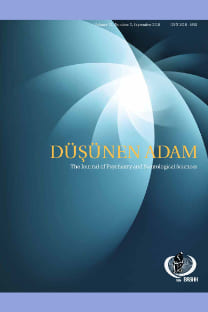Turkish adaptation of the Objectified Body Consciousness Scale and the Self-Objectification Questionnaire
___
Mckinley NM, Hyde JS. The Objectified Body Consciousness Scale: development and validation. Psychol Women Q 1996; 20:181-215.Martins Y, Tiggemann M, Kirkbride A. Those speedos become them: the role of self-objectification in gay and heterosexual men’s body image. Pers Soc Psychol Bull 2007; 33:634-647.
Tiggemann M, Boundy M. Effect of environment and appearance compliment on college women’s self-objectification, mood, body shame and cognitive performance. Psychol Women Q 2008; 32:399-405.
Tiggemann M, Andrew R. Clothes make a difference: the role of self-objectification. Sex Roles 2012; 66:646-654.
Moradi B, Huang YP. Objectification theory and psychology of women: a decade of advances and future directions. Psychol Women Q 2008; 32:377-398.
Augustus-Horvath CL, Tylka TL. A test and extension of objectification theory as it predicts disordered eating: Does women’s age matter? J Couns Psychol 2009; 56:253-265.
Grabe S, Hyde JS, Lindberg SM. Body objectification and depression in adolescents: the role of gender, shame, and rumination. Psychol Women Q 2007; 31:164-175.
Moradi B, Dirks D, Matteson AV. Roles of sexual objectification experiences and internalization of standards of beauty in eating disorder symptomatology: a test and extensive of objectification theory. J Couns Psychol 2005; 52:420-428.
Moradi, B, Varnes, JR. Structure of the objectified body consciousness scale: Reevaluated 20 years later. Sex Roles 2017; 77:325-337.
Noll SM, Fredrickson BL. A mediational model linking selfobjectification, body shame and disordered eating. Psychol Women Q 1998; 22:623-636.
Kozee HB, Tylka TL, Augustus-Horvath CL, Denchik A. Development of psychometric evaluation of the interpersonal sexual objectification scale. Psychol Women Q 2007; 31:176-189.
Fredrickson BL, Roberts TA, Noll SL, Quinn DM, Twenge JM. That swimsuit becomes you: sex differences in selfobjectification, restrained eating and math performance. J Pers Soc Psychol 1998; 75:269-284.
Slater A, Tiggemann M. “Uncool to do sport”: A focus group study of adolescent girls’ reasons for withdrawing from physical activity. Psychol Sport Exerc 2010; 11:619-626.
Fredrickson BL, Roberts TA. Objectification theory: toward understanding women’s lived experiences and mental health risks. Psychol Women Q 1997; 21:173-206.
Tiggemann M, Lynch JE. Body image across the lifespan in adult women: the role of self-objectification. Dev Psychol 2001; 37:243-253.
Dogan G. Objectification and its relation with some variables in college students. Unpublished Master’s thesis, Ankara University, Ankara, 2013. (Turkish)
Franzoi SL, Shields SA. The body esteem scale: multidimensional structure and sex differences in a college population. J Pers Assess 1984; 48:173-178.
Kiropoulos L, Klimidis SA. Self-focused attention scale: factor structure and psychometric properties. Cognit Ther Res 2006; 30:297-306.
Beck AT, Steer RA, Brown GK. BDI-II: Beck Depression Inventory–Second Edition Manual. San Antonio: Pearson, 1996.
Spielberger CD, Gorsuch RL, Lushene RE. STAI Manual for the State-Trait Anxiety Inventory. Palo Alto CA: Consulting Psychologists Press, 1970.
Klimidis S, Minas I. The Mental Health of Ethnic Elderly Groups in Australia: Illness Prevalence, Risk Prevalence and the Association of Risks to Illness. Melbourne: Victorian Transcultural Psychiatry Unit, 1998.
Akin A, Demir T, Akkus Z, Bilgin O, Gunes A. The validity and reliability of Turkish version of the Self-Focused Attention scale. Journal of Educational and Instructional Studies in the World WJEIS 2013; 3:17-20.
Hart EA, Leary MR, Rejeski WJ. The measurement of social physique anxiety. J Sport Exerc Psychol 1989; 11:94-104.
Fenigstein A, Scheier MF, Buss AH. Public and private selfconsciousness: assessment and theory. J Consult Clin Psychol 1975; 43:522-527.
Leary MR. A brief version of the Fear of Negative Evaluation Scale. Pers Soc Psychol Bull 1983; 9:371-375.
Leary MR. Social anxiousness: the construct and its measurement. J Pers Assess 1983; 47:66-75.
Mulazimoglu-Balli O, Asci FH. Reliability and validity of “Social Physique Anxiety Inventory. Spor Bilimleri Dergisi – Hacettepe J of Sport Sciences 2006; 17:11-19. (Turkish)
Berscheid E, Walster E, Bohrnstedt G. Body image - a Psychology Today questionnaire. Psychol Today 1972; 6:57-67.
Thompson JK, van den Berg P, Roehrig M, Guarda AS, Heinberg LJ. The sociocultural attitudes towards appearance scale-3 (SATAQ-3): development and validation. Int J Eat Disord 2004; 35:293-304.
Stice E, Agras WS. Predicting onset and cessation of bulimic behaviors during adolescence: a longitudinal grouping analysis. Behav Ther 1998; 29:257-276.
Garner DM. Eating Disorders Inventory-2: Professional Manual. Odessa, FL: Psychological Assessment Resources, 1991.
Kalafat T, Ozbasi D, Dilek C. Adaptation of the sociocultural attitudes towards appearance scale-3. First National Congress on Testing and Measurement in Education and Psychology, Proceedings book, 2008, 211-225. (Turkish)
Brislin RW, Lonner WJ, Thorndike RM. Cross-Cultural Research Methods. New York: Wiley, 1973.
- ISSN: 1018-8681
- Yayın Aralığı: 4
- Başlangıç: 1984
- Yayıncı: Kare Yayıncılık
A rare type of trichotillomania: rhinotillexomania
Doğancan SÖNMEZ, ÇİÇEK HOCAOĞLU
AYŞE SİBEL DEMİRTAŞ, Banu YILDIZ
Successful treatment of auditory hallucinations in a schizophrenia patient with the use of clonidine
Muhammed Hakan AKSU, Zehra ARIKAN
Işıl GÖZTEPE GÜMÜŞ, Şennur TUTAREL KIŞLAK
Mert BEŞENEK, İnci Türkan YILMAZ, HANDAN GÜLERYÜZ, Sevay ALŞEN GÜNEY, Neslihan İNAL EMİROĞLU
Rechallenge of clozapine in a patient with a history of clozapine-induced myocarditis
Buket KOPARAL, Melike KÜÇÜKKARAPINAR, İrem EKMEKÇİ ERTEK
Co-existence of Beckwith-Wiedemann syndrome and autism spectrum disorder
Alper ALNAK, Dilara BULANIK ÖZDEMİRCİ, MURAT COŞKUN
Pheniramine dependence: a case report
Şengül KOCAMER ŞAHİN, Aslıhan GÜMÜŞLÜ, Derya KAYA, Gülçin ELBOĞA, Abdurrahman ALTINDAĞ
